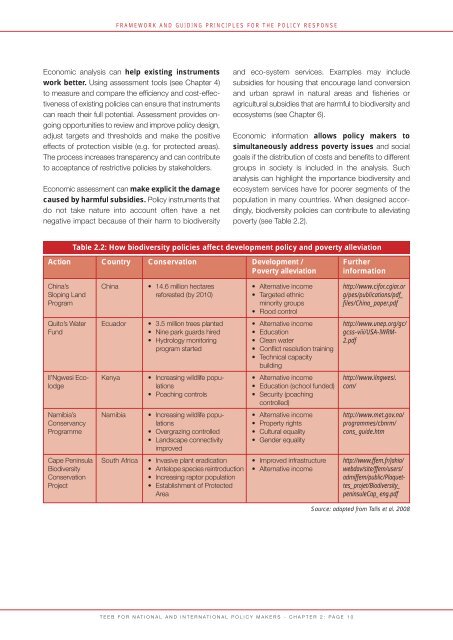Download (PDF, 6.71MB) - TEEB
Download (PDF, 6.71MB) - TEEB
Download (PDF, 6.71MB) - TEEB
Create successful ePaper yourself
Turn your PDF publications into a flip-book with our unique Google optimized e-Paper software.
FRAMEWORK AND GUIDING PRINCIPLES FOR THE POLICY RESPONSE<br />
Economic analysis can help existing instruments<br />
work better. Using assessment tools (see Chapter 4)<br />
to measure and compare the efficiency and cost-effectiveness<br />
of existing policies can ensure that instruments<br />
can reach their full potential. Assessment provides ongoing<br />
opportunities to review and improve policy design,<br />
adjust targets and thresholds and make the positive<br />
effects of protection visible (e.g. for protected areas).<br />
The process increases transparency and can contribute<br />
to acceptance of restrictive policies by stakeholders.<br />
Economic assessment can make explicit the damage<br />
caused by harmful subsidies. Policy instruments that<br />
do not take nature into account often have a net<br />
negative impact because of their harm to biodiversity<br />
Action<br />
China’s<br />
Sloping Land<br />
Program<br />
Quito’s Water<br />
fund<br />
Il’Ngwesi Ecolodge<br />
Namibia’s<br />
Conservancy<br />
Programme<br />
Cape Peninsula<br />
Biodiversity<br />
Conservation<br />
Project<br />
Table 2.2: How biodiversity policies affect development policy and poverty alleviation<br />
Country<br />
China<br />
Ecuador<br />
Kenya<br />
Namibia<br />
South Africa<br />
Conservation<br />
• 14.6 million hectares<br />
reforested (by 2010)<br />
• 3.5 million trees planted<br />
• Nine park guards hired<br />
• hydrology monitoring<br />
program started<br />
• Increasing wildlife populations<br />
• Poaching controls<br />
• Increasing wildlife populations<br />
• overgrazing controlled<br />
• Landscape connectivity<br />
improved<br />
• Invasive plant eradication<br />
• Antelope species reintroduction<br />
• Increasing raptor population<br />
• Establishment of Protected<br />
Area<br />
and eco-system services. Examples may include<br />
subsidies for housing that encourage land conversion<br />
and urban sprawl in natural areas and fisheries or<br />
agricultural subsidies that are harmful to biodiversity and<br />
ecosystems (see Chapter 6).<br />
Economic information allows policy makers to<br />
simultaneously address poverty issues and social<br />
goals if the distribution of costs and benefits to different<br />
groups in society is included in the analysis. Such<br />
analysis can highlight the importance biodiversity and<br />
ecosystem services have for poorer segments of the<br />
population in many countries. When designed accordingly,<br />
biodiversity policies can contribute to alleviating<br />
poverty (see Table 2.2).<br />
Development /<br />
Poverty alleviation<br />
• Alternative income<br />
• Targeted ethnic<br />
minority groups<br />
• flood control<br />
• Alternative income<br />
• Education<br />
• Clean water<br />
• Conflict resolution training<br />
• Technical capacity<br />
building<br />
• Alternative income<br />
• Education (school funded)<br />
• Security (poaching<br />
controlled)<br />
• Alternative income<br />
• Property rights<br />
• Cultural equality<br />
• Gender equality<br />
• Improved infrastructure<br />
• Alternative income<br />
<strong>TEEB</strong> foR NATIoNAL AND INTERNATIoNAL PoLICy MAKERS - ChAPTER 2: PAGE 10<br />
Further<br />
information<br />
http://www.cifor.cgiar.or<br />
g/pes/publications/pdf_<br />
files/China_paper.pdf<br />
http://www.unep.org/gc/<br />
gcss-viii/USA-IWRM-<br />
2.pdf<br />
http://www.ilngwesi.<br />
com/<br />
http://www.met.gov.na/<br />
programmes/cbnrm/<br />
cons_guide.htm<br />
http://www.ffem.fr/jahia/<br />
webdav/site/ffem/users/<br />
admiffem/public/Plaquettes_projet/Biodiversity_<br />
peninsuleCap_eng.pdf<br />
Source: adapted from Tallis et al. 2008

















